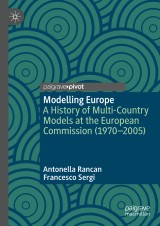Details

Modelling Europe
A History of Multi-Country Models at the European Commission (1970-2005)|
42,79 € |
|
| Verlag: | Palgrave Macmillan |
| Format: | |
| Veröffentl.: | 20.08.2024 |
| ISBN/EAN: | 9783031630910 |
| Sprache: | englisch |
| Anzahl Seiten: | 150 |
Dieses eBook enthält ein Wasserzeichen.
Beschreibungen
<p>What was the role of economists and economics in the making of the European Union? This book sheds light on the activities of a particular type of economic experts: the macroeconomic modellers of the Directorate General for Economic and Financial Affairs (DG II), who built multi-country macroeconomic models of the European Economic Community. These models aim at studying the macroeconomic interactions between national economies and at providing insights about the effects of coordinating (or not) national economic policies. The book documents the origins, challenges, and progress made by DG II’s experts through building these models.</p>
<p>This book provides insight into the influence of multi-country models on modern economics. It will be relevant to students and researchers interested in the history of economic thought and the development of macroeconomic policy.</p>
<p>This book provides insight into the influence of multi-country models on modern economics. It will be relevant to students and researchers interested in the history of economic thought and the development of macroeconomic policy.</p>
1. Macro econometric activities at the SSRC Committee on Economic Stability.- 2. Project Link’s distinctive features and aims.- 3. Connecting national modelling teams.- 4. DG II macroeconomics and the integration process.- 5. Centralized versus decentralized approaches to multi-country models.- 6. The ‘rise and fall’ of Eurolink.- 7. Linking real and financial markets across different countries.- 8. COMPACT and QUEST models.- 9. Modelling the European integration process.- 10. Conclusion.<p></p>
<p><strong>Antonella Rancan</strong> is a Professor of Economics at the University of Molise.</p>
<p><strong>Francesco Sergi</strong> is an Associate Professor of Economics at the Paris-East Créteil University.</p>
<p><strong>Francesco Sergi</strong> is an Associate Professor of Economics at the Paris-East Créteil University.</p>
<p>What was the role of economists and economics in the making of the European Union? This book sheds light on the activities of a particular type of economic experts: the macroeconomic modellers of the Directorate General for Economic and Financial Affairs (DG II), who built multi-country macroeconomic models of the European Economic Community. These models aim at studying the macroeconomic interactions between national economies and at providing insights about the effects of coordinating (or not) national economic policies. The book documents the origins, challenges, and progress made by DG II’s experts through building these models.</p>
<p>This book provides insight into the influence of multi-country models on modern economics. It will be relevant to students and researchers interested in the history of economic thought and the development of macroeconomic policy.</p>
<p> </p>
<p><strong>Antonella Rancan</strong> is a Professor of Economics at the University of Molise.</p>
<p><strong>Francesco Sergi</strong> is an Associate Professor of Economics at the Paris-East Créteil University.</p>
<p>This book provides insight into the influence of multi-country models on modern economics. It will be relevant to students and researchers interested in the history of economic thought and the development of macroeconomic policy.</p>
<p> </p>
<p><strong>Antonella Rancan</strong> is a Professor of Economics at the University of Molise.</p>
<p><strong>Francesco Sergi</strong> is an Associate Professor of Economics at the Paris-East Créteil University.</p>
Contains interviews for the key figures that helped shape and develop multi-country models Highlights how multi-country models have developed and become more sophisticated over the last half century Sheds light on an important, yet mostly overlooked, aspect of economic decision making and policy making


















